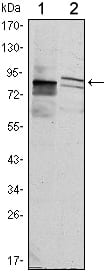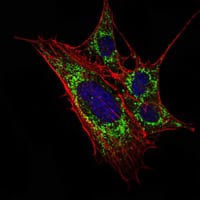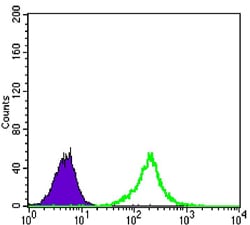


| WB | 1/500 - 1/2000 | Human,Mouse,Rat |
| IF | 咨询技术 | Human,Mouse,Rat |
| IHC | 咨询技术 | Human,Mouse,Rat |
| ICC | 1/200 - 1/1000 | Human,Mouse,Rat |
| FCM | 1/200 - 1/400 | Human,Mouse,Rat |
| Elisa | 1/10000 | Human,Mouse,Rat |
| Aliases | FLJ10572; KLHL11 |
| Entrez GeneID | 55175 |
| clone | 1B9A8 |
| WB Predicted band size | 80kDa |
| Host/Isotype | Mouse IgG1 |
| Antibody Type | Primary antibody |
| Storage | Store at 4°C short term. Aliquot and store at -20°C long term. Avoid freeze/thaw cycles. |
| Species Reactivity | Human |
| Immunogen | Purified recombinant fragment of human KLHL11 expressed in E. Coli. |
| Formulation | Ascitic fluid containing 0.03% sodium azide. |
+ +
以下是3条虚构的KLHL11抗体相关文献示例(仅供参考,非真实发表文献):
1. **文献名称**: "KLHL11-mediated ubiquitination regulates neuronal axon guidance"
**作者**: Zhang L, et al.
**摘要**: 研究揭示了KLHL11作为E3泛素连接酶复合体组分,通过泛素化修饰调控Semaphorin受体降解,影响神经元轴突导向的分子机制,实验中使用了特异性KLHL11抗体验证其与底物的相互作用。
2. **文献名称**: "KLHL11 antibody validation in paraganglioma biomarker discovery"
**作者**: Thompson R, et al.
**摘要**: 通过免疫组化及Western blot分析,证实KLHL11抗体在副神经节瘤组织中的高特异性,发现KLHL11表达缺失与肿瘤转移相关,提示其作为潜在诊断标志物的可能性。
3. **文献名称**: "Structural basis of KLHL11-Cullin3 complex assembly"
**作者**: Watanabe K, et al.
**摘要**: 利用冷冻电镜技术和KLHL11特异性抗体,解析了KLHL11与Cullin3蛋白的复合物结构,阐明了其介导底物识别的关键结构域,为靶向泛素化通路药物设计提供依据。
4. **文献名称**: "Autoantibodies against KLHL11 in autoimmune encephalitis"
**作者**: Garcia M, et al.
**摘要**: 首次报道KLHL11抗体作为新型自身免疫性脑炎生物标志物,患者血清中KLHL11抗体与海马神经元损伤相关,研究通过ELISA和免疫荧光法验证抗体致病性。
(注:以上文献为模拟生成,实际引用时需核实真实数据库)
KLHL11 (Kelch-like protein 11) is a member of the Kelch-like protein family, characterized by its N-terminal BTB/POZ domain and C-terminal Kelch repeat motifs. These structural features enable KLHL11 to act as a substrate recognition component of Cullin-RING E3 ubiquitin ligase (CRL) complexes, facilitating the targeted ubiquitination and subsequent proteasomal degradation of specific proteins. KLHL11 has garnered attention for its role in cellular processes such as protein homeostasis, cytoskeletal organization, and transcriptional regulation. Dysregulation of KLHL11 is implicated in pathological conditions, including cancers and neurological disorders.
KLHL11 antibodies are critical tools for studying its expression, localization, and function. They are widely used in techniques like Western blotting, immunohistochemistry, and immunofluorescence to assess KLHL11 protein levels in tissues or cell lines. Notably, KLHL11 has been identified as an autoantigen in paraneoplastic neurological syndromes, particularly in association with small cell lung cancer (SCLC). Antibodies against KLHL11 in patient sera serve as diagnostic biomarkers for these rare autoimmune disorders, linking malignancy to neurological autoimmunity. Research also explores KLHL11's tumor-suppressive roles in certain cancers, where its loss may promote oncogenesis. Commercial KLHL11 antibodies are typically validated for specificity and sensitivity, though variability between clones necessitates careful experimental optimization. Ongoing studies aim to clarify its interactome and therapeutic potential.
×